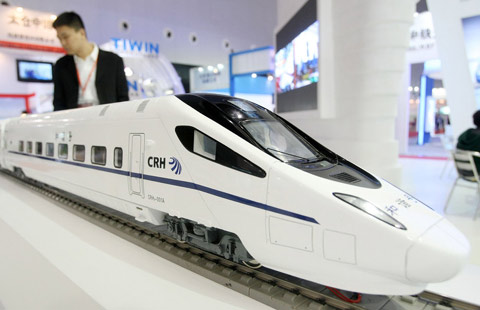Nation's green initiatives to boost investment and create jobs
Updated: 2015-07-21 10:32
By CHAI QIMIN(China Daily)
|
|||||||||||
Climate change has deeply affected our daily lives. Under the principles and requirements of the United Nations Framework Convention on Climate Change, all countries have taken action. The Chinese government has made green low-carbon development the core of ecological civilization.
China has implemented a series of initiatives since the 1990s, especially in the 11th (2006-10) and 12th Five-Year Plan (2011-15), and has achieved remarkable results. This time, China has put together a policy on Enhanced Actions on Climate Change for the Paris conference. This will convey the new concept and vision of sustainable development under the new normal to both an international and domestic audience.
Research in China makes it increasingly clear that action taken on climate change now can drive innovation, strengthen economic growth and bring broad benefits such as improved public health and a better quality of life. It will also produce sustainable development and increase energy security.
Tackling climate change will upgrade traditional industries and social life to a green and intelligent level, develop new technologies, products and business models; stimulate the growth of low-carbon industry and promote the healthy development of the economy. The Chinese Intended Nationally Determined Contribution, or INDC, can create more green investments, jobs and other co-benefits by 2030.
These are the three key points:
・ China will increase its energy supply effectively and invest 1.6 trillion yuan ($257.6 billion) annually by 2030.
Data released by Bloomberg New Energy Finance recently showed that China's renewable energy investment in 2014 increased to $89.5 billion, accounting for 29 percent of the world's total.
According to the State Council's Measures on Accelerating the Development of Energy-saving and Environmental Protection Industries, the output of these industries will reach 6.6 percent of GDP in 2015. China's green financial demand is about 2 trillion yuan annually, and accounts for more than 3 percent of GDP, the Greening China's Financial System Report, released by United Nations Environment Program, revealed.
The new investment on energy efficiency in the 12th Five-Year Plan is expected to reach 2.7 trillion yuan, and that on low-carbon energy (natural gas, non-fossil fuel, etc) will reach 3.1 trillion yuan. The output of low-carbon industry will be about 8.4 trillion yuan. It is predicted that the cumulative investment on low-carbon development will exceed 41 trillion yuan. The low-carbon industry will become the pillar of the national economy. Meanwhile, about 91 percent of the investment will come from private sector and social capital.
・ China will promote green innovation and create 3 million new jobs annually by 2030.
According to the report released by the International Renewable Energy Agency, employment in China's renewable energy industry in 2014 reached 3.39 million, accounting for 44 percent of the total global employment in the sector.
That figure will rise considerably as China's energy efficiency and low-carbon industry expands. New jobs, departments and enterprises are being created, such as carbon finance, carbon audit, carbon inventory, corporate carbon strategy and renewable energy solutions. It is expected that low-carbon employment will reach 63 million by 2030.
With the gradual formation of an industrial system, low-carbon innovation will increase, and the revolution in energy production and consumption will accelerate. This will result in reforms in electric power, oil and gas. New products, services, technologies, models and markets will continue to emerge. Carbon emissions trading is expected to lead the process, reducing the cost of environmental governance.
・ China will shape the green culture effectively and reduce air pollution by 80 percent by 2030.
In low-carbon pilot cities, a new green social order has been set up, such as new-energy vehicles free from purchase and traffic restrictions.
More policies will be introduced in regional and sector levels, to gradually build up a new order of social behaviors, with green standards and social activities being rolled out. Low-carbon development will also reduce air pollution.
The growing demand for public environmental goods and services makes relying solely on government investment unsustainable. The participation of social capital will be required through a reasonable mechanism design.
The new mechanism will let the market play a more important role in the allocation of ecological resources.
The author is deputy director of Strategy and Planning Department, National Center for Climate Change Strategy and International Cooperation.
Related Stories
China's new energy vehicle production surging 2015-07-08 09:35
New energy vehicle industry receives supports in Liangjiang 2015-06-19 17:24
From Technical Catching-Up to Strategic Deployment: The New Energy Vehicle Technology Revolution and China's Countermeasures 2014-10-15 16:25
Policy shift will jolt new-energy vehicle market 2014-07-15 06:57
Looking overseas for new-energy vehicle ideas 2013-11-13 15:03
Today's Top News
UK's Cameron to tackle homegrown extremism
Ling Jihua expelled from CPC,
to face justice
Suicide bombing kills 28 in Turkish border town
Xuzhou looks to UK for talent recruitment
Greek banks reopen amid tax hikes
France returns cultural relics to China
Warren Buffett, Johnny Depp buy Greek islands
Mayor to turn Zhanjiang into green economic powerhouse
Hot Topics
Lunar probe , China growth forecasts, Emission rules get tougher, China seen through 'colored lens', International board,
Editor's Picks

|

|

|

|

|

|






